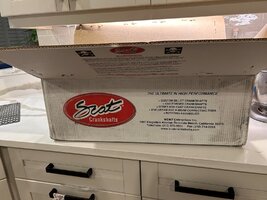Model T crankshaft failure and rebuild....
PART 2
To make sure that this
is a one-time failure - not to be repeated, I finally secured a forged 4340 steel crankshaft (i.e. modern materials and manufacturing) that is a
drop-in fit to the Model T block. This crankshaft is made by SCAT Cranks (the same folks who make hi-perf cranks for your small-block or big-block hot-rod rebuild) and it will NEVER break -
ever.
The original T crank is a 3-main bearing affair that was made from forged steel but it is a known weak point in the engine. The three main bearings (modern 4-cylinders have five main bearings) allows a good degree of crank flex, and while the engine produces only 20 HP - it is a 2.9-litre unit (~177 cu.in.) and that power is made at very low 900 RPM (about the same as the idle speed on our XS650s) with a "red line" of only 1600 RPM. The compression ratio is quoted variously as 3.82:1 up to 4.5:1 (our XS650s are about 8.4:1 and many modern engines run at 10:1 or higher). The peak engine torque is about 80-83 ft-lbs, so the T has good hill-climbing ability - albeit slowly - and takes off from a stop fairly smartly.
All of the above means that the tiny little main journals on the stock crankshaft are under a fair bit of stress (they very are small for an engine of this capacity - only about ...1" - 1-1/8" diameter I'd say). The most common failure mode is a torsional-shear (i.e. a
twisting-off motion) either between cylinders 2 and 3 or right at the back end of the crankshaft where the flywheel flange is located. That is where my crank failed - and it is a nice clean break (see the photo below and zoom in on the centre of the crankshaft). Also of note: there are no web counterbalance weights on the original crank and that makes the engine vibrate - A LOT - which also puts more stress on all of the parts. Henry was big into cost-cutting - and that is fine...but...only 103 years old and it breaks? Geeezzzz...
The new SCAT crank was danged expensive - below is an advert for a brand new Model T crank back in about 1923 - and I paid nearly 400x (

) that amount in CDN dollars...so this had better frickin' work.
View attachment 257919
The typical failure point is at the RH end of the crank where the large flywheel flange joins the much smaller #3 main bearing journal.
NOTE: there is little or no radius at the transition from a smaller diameter crank main journal to the much larger diameter flywheel mounting flange section. Design details are called "stress-risers" in modern engineering parlance and every undergrad knows to avoid them at all costs. I guess when Henry and his boys were designing the Model T engine in about 1907-8....such things were not as well understood. Anyhow - the $7.25 price (

) makes me weep. Modern cranks have a big radius at each change of cross-section and it is polished to eliminate micro-cracks that can grow into big failures (....like mine did

).
...and here is the snazzy new SCAT crank in its box - note the counterbalances on each crankpin web which will result in much smoother running and less stress on the bearings and polished transitions between the bearing journals and the crank webs. The new crankshaft is made out of the same high tensile strength steel alloy as the cranks in modern cars - with a yield strength of well over 100,000 psi (about 750 kPa) - which is at least 4-5 times stronger than the original Model T crankshaft, plus it has much better geometry with larger journals and well-radiused and polished section changes than the original part.
As I said - it should not break -
ever.
View attachment 257917
The photos below were taken at the engine rebuilder's shop yesterday. It depicts the flywheel-end of the crank looking forward with the engine upside down. The generator mounting flange is visible on the left side of the block as are the cam-timing and generator drive gears way up at the front of the engine. You can also see the block-mounted camshaft (it is a flathead engine) down inside the left side of the upside-down block.
NOTE: the silvery twisted-off crankshaft end, the safety-wired castle-nutted rod-bolts, and the cute little sheet metal oil "dippers" scoops on each conn-rod to aid with lubrication (no oil pump in a Model T -
thanks Henry!). The dippers are an aftermarket enhancement that many original Model T owners added back in the day after having problems with main and rod bearings.
View attachment 257914
...and here is the flywheel-starter ring gear and magneto assembly - the crankshaft flange is still stuck in the centre of the flywheel hub and you can see the silvery-looking twisted-off stub of the crank (

).
View attachment 257915
The engine rebuilder has inspected everything and he tells me that all is well with the block, pistons and rods, the head, cam and valves and so the only engine part that must actually be replaced is the crankshaft itself. He has looked over the transmission bands (it is a two-speed planetary gearbox) and he will replace the bands with modern kevlar-lined units that should not wear out for many miles - if ever.
He tells me that he
may be able to line-bore the existing babbit out to fit the larger journals on the SCAT crank - or he may need to pour new babbit - we will see about that over the next couple of weeks.
So - aside from the brutal cost of the new crank, I got off pretty lightly on this little fiasco.
Pete




 ).
). ).
).